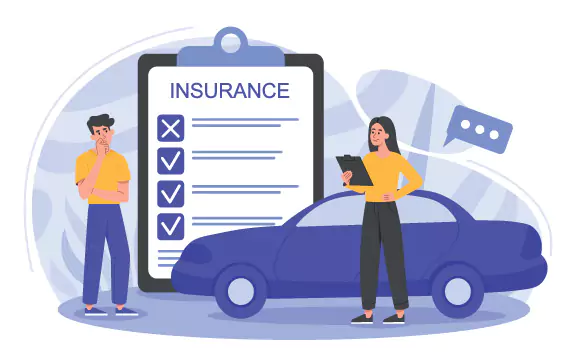Understanding auto insurance in the USA can be challenging, especially if you’re new to the country. It’s important to be aware of the specific auto insurance requirements in each state, as the laws vary widely.
This guide will explain the types of auto insurance coverage required by different states, why they are important, and how you can make sure you’re fully protected on the road.
Types of Auto Insurance Coverage Required by States
*click here to go directly to the state minimums table
Before diving into the specific requirements for each state, it’s important to understand the main types of auto insurance coverage that are commonly required:
1. Liability Insurance
Liability insurance is the most common type of coverage required by states. It has two main components:
Bodily Injury Liability (BI): This covers medical expenses and legal fees if you’re at fault in an accident and injure others. For example, if you cause an accident that injures another driver or pedestrian, this coverage will help pay their medical bills. This coverage often has limits expressed on a per-person basis and per-accident basis.
Property Damage Liability (PD): This covers the cost of repairing or replacing property that you damage in an accident. For instance, if you hit another vehicle or damage someone’s fence, this coverage will help cover the costs.
2. Personal Injury Protection (PIP)
Personal Injury Protection, or PIP, is required in some states. PIP covers medical expenses, lost wages, and other costs for you and your passengers, regardless of who is at fault for bodily injury in the accident. It’s especially important in “no-fault” states, where each party’s insurance pays for their own injuries.
3. Uninsured/Underinsured Motorist Coverage (UM/UIM)
Uninsured/Underinsured Motorist Coverage protects you if you’re involved in an accident with a driver who has no insurance or insufficient coverage. Uninsured motorist coverage can pay for your medical expenses, lost wages, and other damages when the other driver is unable to cover the costs.
4. Medical Payments Coverage (MedPay)
Medical Payments Coverage, or MedPay, is an optional coverage in many states that helps cover medical expenses for you and your passengers, regardless of who caused the car accident first. Unlike PIP, MedPay does not cover lost wages or other non-medical expenses.
5. Collision and Comprehensive Coverage
While not typically required by state law, collision and comprehensive coverage are often required by lenders if you’re financing or leasing your vehicle.
Collision Coverage: Pays for damages to your car resulting from a collision with another vehicle or object, such as a tree or guardrail.
Comprehensive Coverage: Covers damages to your car from non-collision events like theft, fire, vandalism, or natural disasters.
Car Insurance Coverage Requirements by State
Car insurance minimum coverage requirements (also known as minimum limits) vary significantly by state. Some states require only basic liability insurance, while others mandate additional coverages like PIP or UM/UIM. Below is a table showing the minimum required coverage for each state.
This table includes the minimum amounts for bodily injury coverage, property damage, and other required coverages. It’s important to remember that these are just the minimums—many drivers choose to carry higher limits for better protection.
This table includes the minimum amounts for bodily injury coverage, property damage, and other required coverages. It’s important to remember that these are just the minimums—many drivers choose to carry higher limits for better protection.
States with Unique or No Traditional Insurance Requirements
While most states require drivers to carry auto insurance, a few states have unique requirements:
New Hampshire
New Hampshire is the only state that does not require auto insurance. However, if you cause an accident, you must prove that you can pay for any damages, which is typically done through an insurance policy. Drivers who choose not to carry insurance must demonstrate “financial responsibility,” meaning they have the financial means to cover any damages resulting from an accident.
Virginia
In Virginia, drivers have the option to pay an uninsured motor vehicle fee instead of carrying insurance. This fee allows you to drive uninsured, but it does not provide any coverage if you’re involved in an accident. You would be personally responsible for paying for any damages or injuries you cause, per accident.
Other States with Alternative Requirements
Some states allow drivers to meet minimum car insurance requirements through alternative means, such as posting a bond or cash deposit with the state. These alternatives can be more complex and often require significant financial resources.
For example:
California: Drivers can post a $35,000 cash deposit or surety bond as an alternative to carrying traditional auto insurance.
Florida: Offers an option for drivers to provide proof of financial responsibility through a $40,000 net worth certificate.

Optional Coverages to Consider
While meeting your state’s minimum insurance requirements is necessary, it may not be enough to fully protect you. Here are some additional coverage options you might want to consider:
Collision and Comprehensive Coverage
Even if your state doesn’t require these coverages, they can be invaluable in protecting your vehicle from a wide range of risks, including accidents, theft, and natural disasters.
Rental Reimbursement and Roadside Assistance
These coverages can be very helpful if your car is in the shop after an accident or if you find yourself stranded on the road. Rental reimbursement covers the cost of a rental car while your vehicle is being repaired, and roadside assistance covers towing and other emergency services.
Higher Liability Coverage Limits
While your state’s minimum requirements might be enough to keep you legal on the road, they may not be enough to cover all the costs associated with a serious accident. Many drivers choose to carry higher liability coverage limits for added financial protection.
Frequently Asked Questions (FAQs)
Q: What happens if I move to a different state?
A: If you move to a new state, you’ll need to update your auto insurance policy to meet the new state’s minimum requirements. Most insurance companies allow you to easily transfer your coverage when you move.
Q: Do I need to carry proof of insurance at all times?
A: Yes, most states require you to carry proof of insurance in your vehicle at all times. This can be in the form of an insurance card or a digital copy on your smartphone.
Q: Is the coverage paid per accident, or is it a one-time payment?
A: Auto insurance coverage is typically paid per accident. This means that if you’re involved in multiple accidents, your insurance will pay up to the policy limits for each separate incident, as long as the policy is active and in good standing.
Q: Can I drive without insurance in states like New Hampshire or Virginia?
A: While you technically can drive without insurance in these states, it’s risky. In New Hampshire, you must prove you can cover damages in case of an accident, and in Virginia, the uninsured motorist fee does not provide any accident coverage.
Q: What’s the difference between minimum and full coverage?
A: Minimum coverage typically includes just the basic liability required by your state. Full coverage usually includes collision and comprehensive insurance in addition to the minimum requirements, providing more extensive protection.
Q: How do I find the best auto insurance coverage for my needs?
A: Start by comparing quotes from different insurance companies, considering not only the price but also the coverage options and customer service. Make sure to choose a policy that meets or exceeds your state’s minimum requirements and fits your personal needs.
Q: What happens if I drive without insurance?
A: Driving without insurance can result in severe penalties, including fines, license suspension, and even jail time in some states. If you’re involved in an accident without insurance, you could be held personally liable for any damages or injuries, which can be financially devastating.
Find the Best Coverage that Fits Your Needs and Financial responsibility Situation
Understanding the auto insurance coverage requirements in your state is crucial for staying legal on the road and protecting yourself financially. Use this information to find the best insurance rates and carriers for your state, ensuring you have the right coverage to keep you safe and secure.

